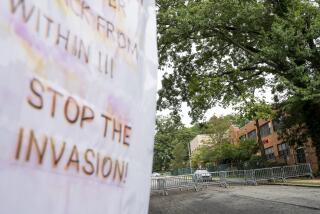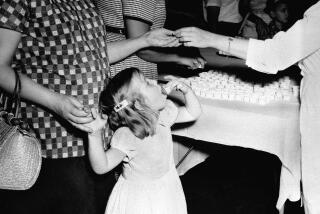New York City officials struggle for balanced response to swine flu
NEW YORK — At a hospital in New York’s South Bronx, 187 children flooded the emergency room in a 12-hour period. Only two had flu-like symptoms, and those were mild. At a hospital in Queens, officials erected a tent outside to handle the crowd of visitors fearful of the H1N1 influenza virus, even though none had obvious symptoms.
They are part of what Mayor Michael R. Bloomberg and other city officials have dubbed the “worried well,” whose epidemic of panic amid the swine flu outbreak is proving more problematic than the illness.
As of Wednesday afternoon, New York had one confirmed death from H1N1 -- that of a school administrator from Queens. Across the state, there have been 284 confirmed cases, with 201 of those in New York City.
The numbers, reported by the Centers for Disease Control and Prevention, are small in comparison with some other states: 553 in California, 794 in Illinois, 766 in Wisconsin and 556 (including three deaths) in Texas.
But in a teeming city where millions ride nose to nose in crowded subways, where people literally rub shoulders in bustling delis, corner markets and on the street, and where sneezing, coughing and spitting are as much a part of the background noise as the honking of taxicab horns, the idea of a potentially fatal virus on the loose is bound to spark fear.
The problem confronting city officials is how to quell that fear without seeming insensitive to normal parental concerns or out of touch with New Yorkers in the mainly working-class, immigrant-heavy communities that appear most worried.
One assemblyman on Wednesday compared the situation to the fear that gripped New York after the Sept. 11 attacks, and said it was the mayor’s duty to do a better job of calming people.
Bloomberg’s approach has been to deliver matter-of-fact flu updates -- heavy on practical advice about the virtues of hand-washing and covering the mouth while coughing, and light on fear-mongering.
A briefing Wednesday at City Hall was no different. The mayor began by announcing that a pair of local newspaper reporters had had a baby. He went on to discuss an upcoming fashion event aimed at stimulating the retail industry. Ninety minutes later, Bloomberg turned his attention to H1N1, focusing on the problems that city officials say are being created by the “worried well.”
“While there are an abnormal number of people going to the hospital who are worried, a very tiny percentage have any symptoms whatsoever,” said Bloomberg, who was flanked by the city’s health commissioner, Dr. Thomas R. Frieden, who was just appointed to lead the CDC; and Alan Aviles, president of the city’s Health and Hospitals Corp.
The mayor offered condolences to the family of Mitchell Wiener, New York’s H1N1 victim who was buried Wednesday. He also noted the death of a 16-month-old boy, Jonathan Zamora, on Monday night in Queens. Frieden and Bloomberg said that initial tests on the toddler were negative for H1N1 but that more testing would be done at the CDC.
The New York Daily News quoted the baby’s father, Zeferino Zamora, as insisting that his son did not have the flu. “People should not panic. It’s not what people think,” he said.
But some people are panicking. Aviles said that hospital emergency rooms were seeing a 20% jump in adult patients and a 50% increase in children. The preponderance of those showing up are 5- to 17-year-olds, herded there by parents.
“What we’ve seen . . . is a lot of concern, but very few sick kids,” Frieden said.
On Tuesday, the situation became so bad at the Queens Hospital Center that the tent was set up outside, allowing doctors inside to treat patients who really needed help, Bloomberg said. The tent was dismantled Wednesday morning.
Frieden and Bloomberg rejected arguments that it would be best to close New York schools, or to at least provide detailed absentee figures so that parents would know whether their children’s schools might be affected by the flu.
Absentee rates say little about actual illness trends because so many parents are keeping children home for fear they could get sick, not because they are, Frieden said.
Only one school in New York -- Intermediate School 238 in Hollis, Queens, where Wiener worked -- has confirmed H1N1 cases. At least 26 schools across the city, including I.S. 238, were closed Wednesday.
As for mass school closures, Bloomberg bristled at the idea, saying that it would interrupt the educational process and create economic hardship for many parents forced to take time off work.
“Parents have the right to keep their kids at home, but we have the obligation to provide an education to those who want to send their kids to school,” he said.
Bloomberg, who is up for reelection in November, reiterated the main points of his flu briefing in Spanish. But his critics cast the mayor as being detached from many of his constituents.
State Assemblyman Jose R. Peralta, whose district includes fear-gripped sections of Queens, has called a town hall meeting to discuss the flu outbreak -- and criticized Bloomberg and city health officials for not taking part.
A spokeswoman for Peralta, Damaris Mone, said the mayor’s assumption that all New Yorkers read newspapers and watch television news showed his disconnect with an ethnically diverse population. For New Yorkers for whom English is not necessarily a first language, she said, direct communication is the best way to assuage fear.
“This is the first crisis we’ve had since 9/11,” Mone said, “and you’re telling me you don’t talk to the community?”
--
More to Read
Sign up for Essential California
The most important California stories and recommendations in your inbox every morning.
You may occasionally receive promotional content from the Los Angeles Times.











